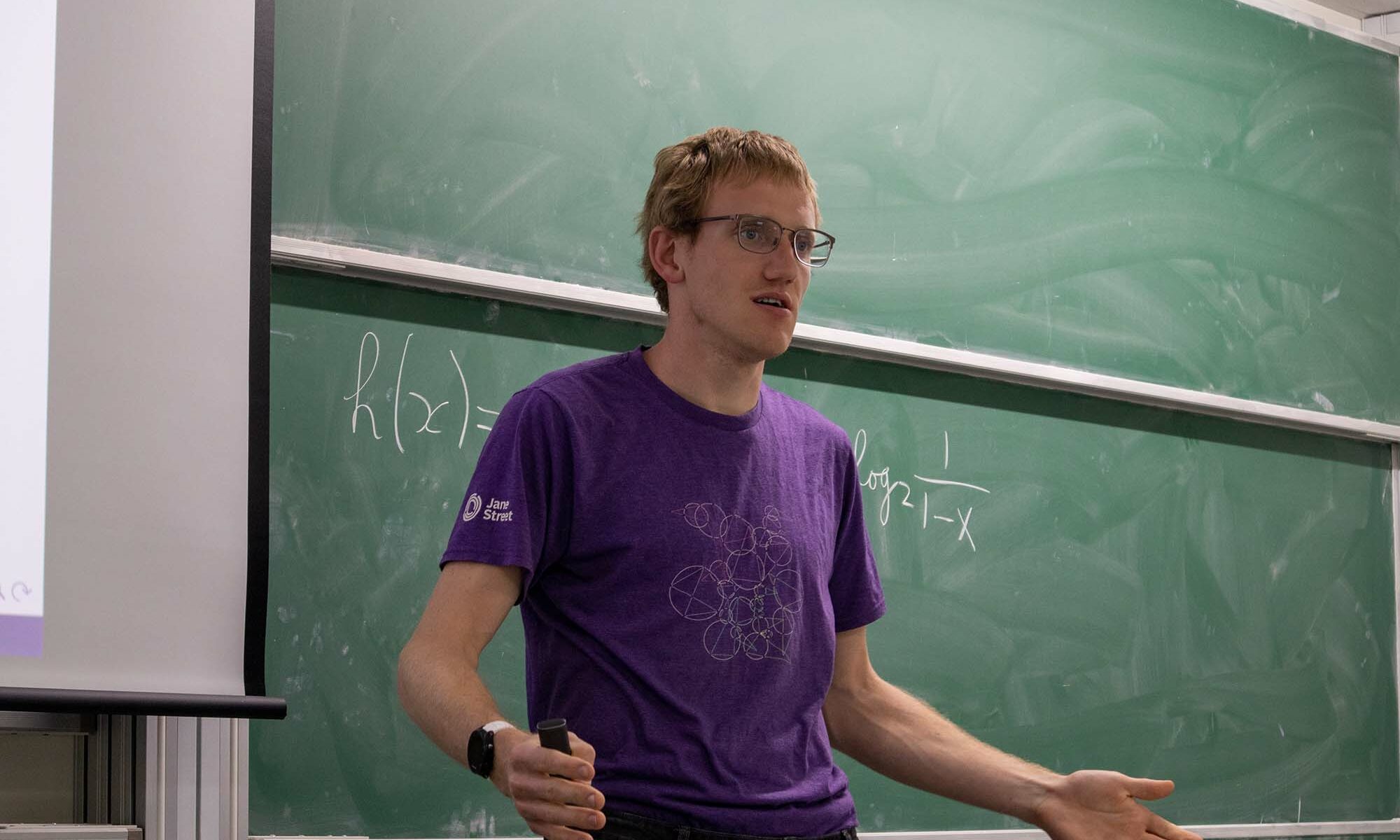On March 14, 2023, Stijn Cambie from the IBS Extremal Probability and Combinatorics Group gave a talk at the Discrete Math Seminar on recent developments regarding the union-closed sets conjecture initiated by Justin Gilmer. The title of his talk was “Recent progress on the Union-closed conjecture and related“.
Stijn Cambie, Recent progress on the Union-closed conjecture and related
We give a summary on the work of the last months related to Frankl’s Union-Closed conjecture and its offsprings. The initial conjecture is stated as a theorem in extremal set theory; when a family F is union-closed (the union of sets of F is itself a set of $\mathcal F$), then $\mathcal F$ contains an (abundant) element that belongs to at least half of the sets. Meanwhile, there are many related versions of the conjecture due to Frankl. For example, graph theorists may prefer the equivalent statement that every bipartite graph has a vertex that belongs to no more than half of the maximal independent sets. While even proving the ε-Union-Closed Sets Conjecture was out of reach, Poonen and Cui & Hu conjectured already stronger forms.
At the end of last year, progress was made on many of these conjectures. Gilmer proved the ε-Union-Closed Sets Conjecture using an elegant entropy-based method which was sharpened by many others. Despite a sharp approximate form of the union-closed conjecture as stated by Chase and Lovett, a further improvement was possible. In a different direction, Kabela, Polak and Teska constructed union-closed family sets with large sets and few abundant elements.
This talk will keep the audience up-to-date and give them insight in the main ideas.
People who would like more details, can join the Ecopro-reading session on the 14th of March (10 o’clock, B332) as well. Here we go deeper in the core of the proofs and discuss possible directions for the full resolution.
Stijn Cambie gave a talk on the number of maximal independent sets at the Discrete Math Seminar
On December 28, 2022, Stijn Cambie from the IBS Extremal Combinatorics and Probability Group gave a talk at the Discrete Math Seminar on various problems on the number of independent sets, including the problem of finding a graph with a given number of independent sets of fixed size. The title of his talk was “The 69-conjecture and more surprises on the number of independent sets“.
Stijn Cambie, The 69-conjecture and more surprises on the number of independent sets
Various types of independent sets have been studied for decades. As an example, the minimum number of maximal independent sets in a connected graph of given order is easy to determine (hint; the answer is written in the stars). When considering this question for twin-free graphs, it becomes less trivial and one discovers some surprising behaviour. The minimum number of maximal independent sets turns out to be;
- logarithmic in the number of vertices for arbitrary graphs,
- linear for bipartite graphs
- and exponential for trees.
Finally, we also have a sneak peek on the 69-conjecture, part of an unpublished work on an inverse problem on the number of independent sets.
In this talk, we will focus on the basic concepts, the intuition behind the statements and sketch some proof ideas.
The talk is based on joint work with Stephan Wagner, with the main chunk being available at arXiv:2211.04357.
Stijn Cambie gave a talk on the diameter of the reconfiguration graphs arising from the list coloring and the DP-coloring of graphs at the Discrete Math Seminar
On May 23, 2022, Stijn Cambie from the IBS Extremal Combinatorics and Probability Group gave a talk at the Discrete Math Seminar on the problem of determining the diameter of the reconfiguration graphs arising from the list coloring and the DP-coloring of graphs. The title of his talk was “The precise diameter of reconfiguration graphs“.
Stijn Cambie, The precise diameter of reconfiguration graphs
Reconfiguration is about changing instances in small steps. For example, one can perform certain moves on a Rubik’s cube, each of them changing its configuration a bit. In this case, in at most 20 steps, one can end up with the preferred result. One could construct a graph with as nodes the possible configurations of the Rubik’s cube (up to some isomorphism) and connect two nodes if one can be obtained by applying only one move to the other. Finding an optimal solution, i.e. a minimum number of moves to solve a Rubik’s cube is now equivalent to finding the distance in the graph.
We will wonder about similar problems in reconfiguration, but applied to list- and DP-colouring. In this case, the small step consists of recolouring precisely one vertex. Now we will be interested in the diameter of the reconfiguration graph and show that sometimes we can determine the precise diameters of these.
As such, during this talk, we present some main ideas of [arXiv:2204.07928].
Welcome Stijn Cambie, a new member of the IBS Extremal Combinatorics and Probability Group
The IBS Discrete Mathematics Group welcomes Dr. Stijn Cambie, a new (and first) research fellow at the IBS Extremal Combinatorics and Probability Group from May 16, 2022. He received his Ph.D. from the Radboud University in the Netherlands under the supervision of Prof. Ross Kang. He is interested in extremal problems on various graph parameters and in extremal set theory.





